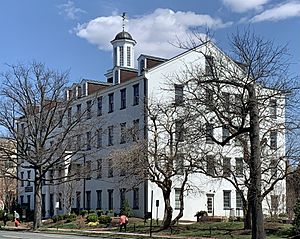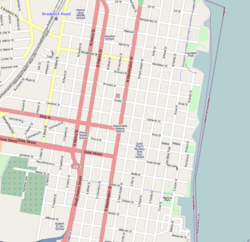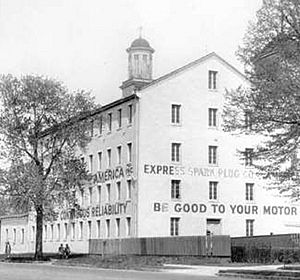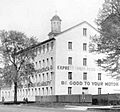515 North Washington Street facts for kids
Quick facts for kids |
|
|
515 North Washington Street
|
|
|
U.S. Historic district
Contributing property |
|

515 North Washington Street in 2022
|
|
| Location | 515 North Washington Street Alexandria, Virginia |
|---|---|
| Built | 1848 |
| Part of | Alexandria Historic District |
| Designated CP | November 13, 1966 |
The old building at 515 North Washington Street in Alexandria, Virginia, has had many uses. It started as a cotton mill. Later, it became a prison, a factory, offices, and even apartments. It was built in 1848 by the Mount Vernon Manufacturing Company. This was in the area now known as Old Town Alexandria.
The first owners did not do well with their cotton mill business. They sold the building in 1855. The new owner fixed it up and ran a successful business. But his success ended when the Civil War began. The Union Army took over many local businesses, including this one, after they entered Alexandria.
For a short time, the building was a hospital and a warehouse. Then, it became the Washington Street Military Prison. This was the biggest of five Civil War prisons in Alexandria. In 1864, Rufus Dudley Pettit became the warden. He was known for treating prisoners very badly.
After the war, the building briefly went back to being a cotton mill. But that business also failed. The building was sold and stayed empty until 1902. That year, Robert Portner and his Portner Brewing Company bought it. The building was used as a bottling plant. It closed when Virginia passed Prohibition laws.
Later, the Express Spark Plug Company bought it. They made spark plugs there until 1928. In the 1930s, the building became the Belle Haven Apartment House. It was used for homes until 1981. Then, it was updated to be office space. The International Association of Chiefs of Police had their main office here from 1992 to 2014.
In 2014, the building was updated again. Because it is a contributing property to the Alexandria Historic District, groups that protect old buildings reviewed the plans. The property was turned into The Mill. This is an apartment building with 25 units. It still has its original old details and a park next to it.
An interesting thing about the building is a mannequin named Oscar. He sits in the small tower called a cupola. There are a few stories about how Oscar got there. The most likely story is that he arrived around 1920. Another story says prison guards used him as a stand-in when they took breaks. Oscar is now seen as an important part of the building's history. He was carefully protected during the most recent updates.
Contents
The Building's Story: From Mill to Apartments
Early Days and Cotton Production
In 1847, some business people started the Mount Vernon Manufacturing Company. They bought a piece of land in Alexandria, Virginia. The next year, they finished building a five-story brick building. It was 110 feet long and 50 feet wide. It had a cupola on top and other smaller buildings.
This building became Alexandria's first cotton mill. About 150 people worked there, mostly women. They worked 11 hours a day and earned $12 to $17 a month. The mill used two steam engines to power its machines. It had 3,840 spindles and 124 looms to make cotton cloth.
The cotton mill did not make much money. In 1855, the owners decided to sell it for $26,000. This price included the factory and other small buildings. Three years later, the new owners sold it to John Rosencrantz for $35,000. After he fixed it up, the factory reopened. It did well for several years, making about 5,000 yards of cotton cloth every day.
The Civil War Period
During the Civil War, Virginia decided to leave the Union in April 1861. The next month, on May 24, the Union Army came into Alexandria. This was to protect Washington, D.C. and to start attacks further south. Many people who supported the Confederacy left Alexandria. Union troops took over some local businesses. The cotton mill was a large building, so the Union Army took it over.
The Union Army changed the mill into a hospital and a warehouse. Later, it became a prison. They renamed it the Washington Street Military Prison. It was the biggest of five military prisons in Alexandria during the war. The others were the City Jail, the Franklin and Armfield Office, the Green Furniture Factory, and the Odd Fellows Hall. This prison held Confederate soldiers and Union soldiers who had left the army. The building was painted white, and a fence was added around it. Up to 1,500 prisoners could be held there at one time.
At first, prisoners at Washington Street Military Prison were treated well. They had enough food and clothes. But this changed when Captain Rufus Dudley Pettit took charge of Alexandria's military prisons. Pettit had fought in big battles for the Union Army. But he had to leave active duty because he was sick.
After Pettit took over the prisons, he became known for being very harsh. He ordered prisoners to be handcuffed behind their backs and hung from the ceiling. Or they were handcuffed by their wrists and left outside for 12 hours. They were exposed to rain or very hot or cold weather. Prisoners were often beaten and had broken bones. Pettit would sometimes stand outside and shoot at prisoners who tried to look out the windows.
After the war, Pettit's harsh actions caught the attention of his leaders. He faced a military trial in November 1865. Pettit was found guilty of treating prisoners badly. He was removed from the Army in disgrace. He then moved to New York and became a lawyer. Papers from Pettit's time as warden are kept at the Alexandria Library.
Later Industrial Uses
In 1866, a businessman named Abijah Thomas bought the building. He tried to make the cotton mill successful again. But his business did not do well. The building was later bought by Robert Garrett in 1877 for $33,000. He closed it so it would not compete with his business in Maryland.
The building stayed empty until 1900. Garrett's family sold it for $12,000. Two years later, it was sold at a public auction. Harry and John Aitcheson bought it for the Robert Portner Corporation, owned by Robert Portner.
For the next 14 years, the building was a bottling plant for the Portner Brewing Company. But in 1916, Virginia passed Prohibition laws. This meant alcohol could not be made or sold, so the plant closed. In 1918, the Express Spark Plug Company bought the property. They made spark plugs in the building until 1928. The company painted large letters on the building with its name and slogans. These included "Be Good to Your Motor" and "The plug of continuous reliability." After the factory closed, the building was used by the United States Department of Agriculture during the early years of the Great Depression.
Becoming Homes and Offices
In 1935, the building was changed into homes. It became the Belle Haven Apartment House. A fancy entrance with Corinthian columns was added. Around this time, a mannequin named Oscar became famous. He had been in a second-floor window for several years. A reporter wanted to know Oscar's story. He heard a few ideas about where Oscar came from.
The most likely story is that Oscar was placed there around 1920 by the Bureau of Fisheries. He was used to advertise angling (fishing). One worker from the spark plug factory said, "We used to keep it back here at the end of this room. It looked so natural and lifelike we would play practical jokes with it." Another story says that during the Civil War, a prison guard would put Oscar in the cupola when he took a break. A more well-known rumor is that local police put Oscar in the cupola to trick a murderer from 1854 to return to the building.
The Belle Haven Apartment House was changed into office space in 1981. A real estate agent named Bud Jordan found Oscar in the attic. He dressed Oscar in one of his suits and put him next to a lamp in the cupola. He later told a reporter, "People used to stop and come into the office and say, you know there's a guy up there and he doesn't seem to be moving? I know that's my suit and tie and hat that we dressed him in."
In 1992, the International Association of Chiefs of Police bought the building for $3.1 million. It was their main office until 2014. During that time, the cupola glass was fixed, and Oscar was briefly moved. In late 2013, a real estate company bought the building for $5.2 million. They planned to turn it into a 25-unit apartment building.
Because it is a historical building and a contributing property to the Alexandria Historic District, the renovation needed approval from several groups. These included the Upper Old Town Design Advisory Committee, the Alexandria Board of Architectural Review, and the National Park Service. The finished project was renamed The Mill. It has 25 apartments with one or two bedrooms. They have high ceilings and original old details. There is also a park next to the building and an event space on the top floor. This space has views of Old Town Alexandria and the Potomac River.
The company hired the Cooper Carry architectural firm to design the renovation. They were told to treat Oscar with care. One of the architects, Brandon Lenk, said, "The best way to put it is it was treated as though it was a historical aspect of the building." Lenk also noticed Oscar was missing a leg and wearing old, faded clothes.
Images for kids







